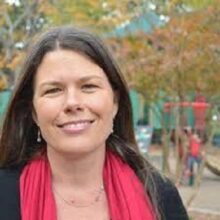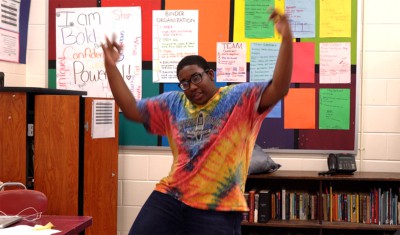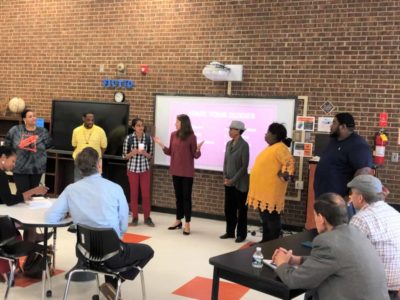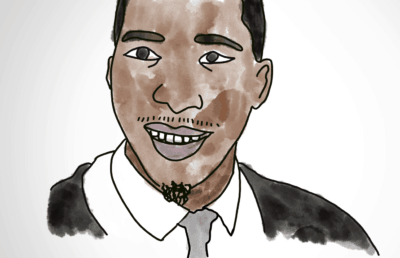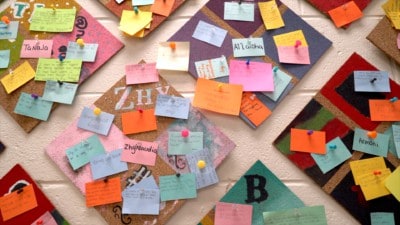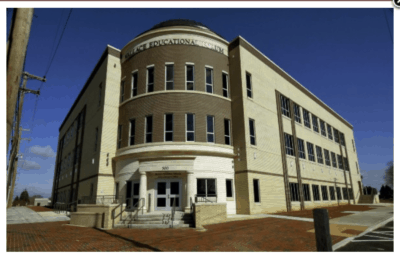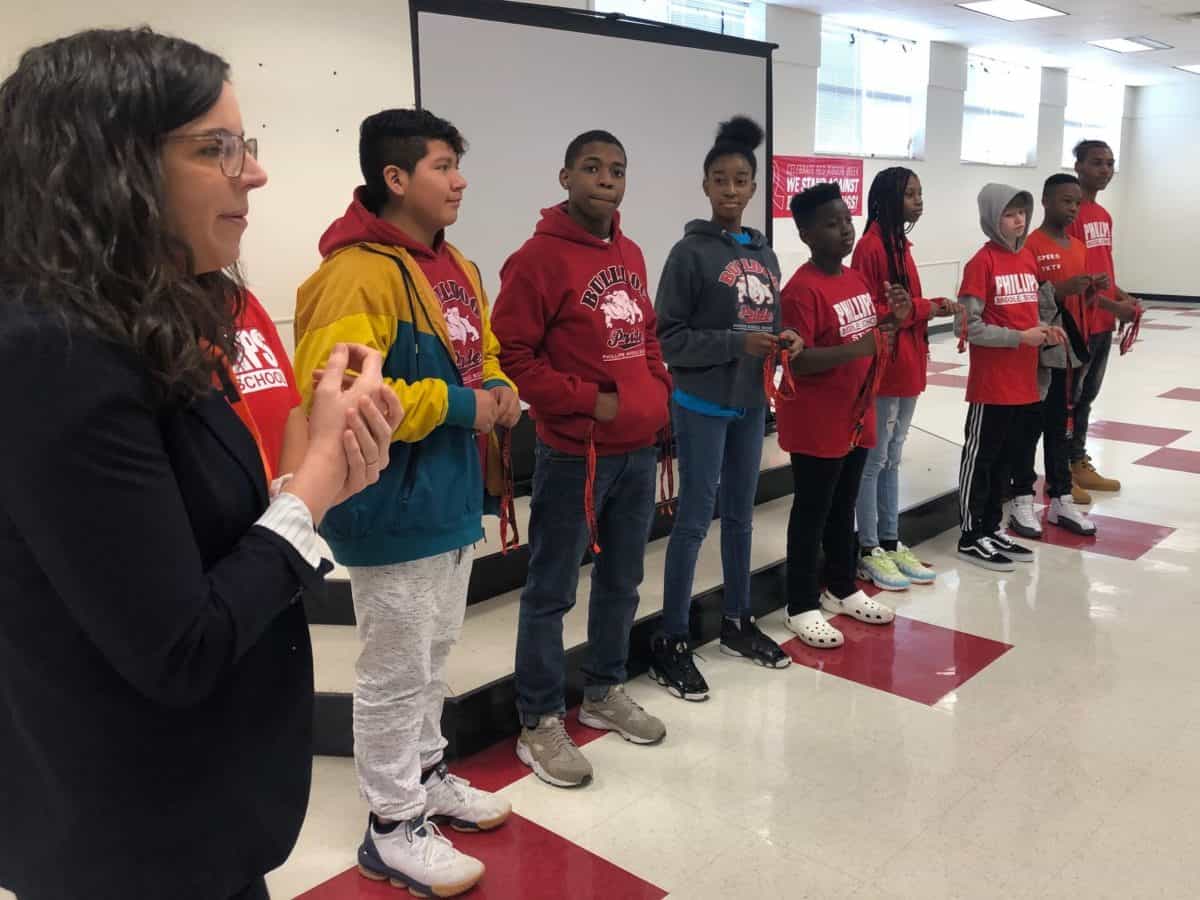
On Tuesday, April 14, 2020, the Hunt Institute hosted a virtual webinar, “Supporting Student Needs Amidst School Closures.” The webinar included Dr. John Gordon III, the superintendent of Suffolk Public Schools; Shelly Parks, the 2019 Missouri Teacher of the year; and North Carolina Principal Jenny O’Meara. The panelists discussed how educators are meeting the diverse needs of students during COVID-19, including instructional, nutritional, and social-emotional needs.
O’Meara is the principal of Phillips Middle School in Battleboro in Edgecombe County.
“This time is a historic moment. We’ve got to capture as much as we can right now, and we’ve got to learn as much as we can right now, and make sure that we are designing the school that our kids need and deserve.” — Jenny O’Meara
The community O’Meara serves is known as the “Northside.” She says, “our community has really strong rural values, just a deep commitment to place and to one another, and a very rich history.”
“The pull to the status quo when you are in a traditional school building every day is very strong,” said O’Meara. Right now — while there is no bus duty, no lunch duty, and no discipline issues — O’Meara is being intentional about using this time to think about the future of education.
O’Meara’s school district was committed to innovation long before COVID-19. EdNC has been in embedded in the district, documenting the best practices being developed and iterated.
O’Meara’s team at Phillips Middle School and a cohort of leaders in the district hold a deep commitment to redesign school, to reimagine education. O’Meara wants Phillips to be “the perfect place to learn and experience love and belonging” for her students.
O’Meara says, “the industrial model of education doesn’t work for every kid, certainly not kids that look like ours. If we want different outcomes for our kids, we are going to have to start doing things differently.”
The idea is for school going forward to be designed with students and student voice at the center “of every learning experience we design.” It is important, O’Meara notes, to design with students and the community, and not for them. The team uses the practices of human- and equity-centered design thinking, the science of learning, and future trends to hold themselves accountable to school experiences that will prepare the students for the futures they dream of.
“Everything we’ve done for the past few years prepared us for this moment,” says O’Meara. “Teachers [have been] flexing design muscles, taking risks in the classroom and learning from them, growing in their own ability to make and deliver new learning experiences.”
In this rural county, not all of the students have access to internet or even cell service. O’Meara asked her teachers to prepare and align instructional packets and online assignments so kids would have access to the same learning opportunities. The packets are delivered to students via the buses that are also delivering meals to students that need them.
O’Meara is striving to keep students “at the center of everything we do.” Every student is contacted at least twice a week, and right now, her school counselor and dean of students are working together to make sure at-risk kids are getting contacted even more frequently. As educators are in touch with students, they are developing a way to share insights about students with the Phillips team.
“Our teachers know our kids, know their unique differences, and they are able to design learning experiences to make sure every single one of them is getting what they need and deserve.” — Jenny O’Meara
O’Meara continues to communicate with her team via a newsletter, but during COVID-19, she has added a self-care section.
“You get your energy from being around kids when you are an educator,” says O’Meara. Many educators are grieving the loss of seeing their students each day. As principal, she suggests supporting teachers first as people, giving them permission to find a new normal for themselves.
The instructional team at Phillips is conducting empathy interviews with students — some for whom school is working well, and others for whom school is not working so well. The interviews will inform how the school moves forward.
O’Meara is creating safe spaces for educators to share, borrow and iterate ideas, and document best practices. The team is capturing teacher reflections on the experience daily.
She hopes her teachers use this time to get to know themselves and each other more deeply.
“When we get back, I want them to be the most phenomenal, collaborative team that there ever was in any school because that’s what it takes to do something different,” said O’Meara.
On Friday, April 17, 2020, AASA (The School Superintendents Association) hosted a virtual webinar, “Pivot to eLearning at Scale: K-12 Leadership Test.” The webinar included Gustavo Balderas, a superintendent in Eugene, Oregon, and the 2020 Superintendent of the Year; Eric Williams, a superintendent in Loudoun County, Virginia; Dave Schuler, the superintendent of District 214 in Illinois and the 2018 Superintendent of the year; and North Carolina Superintendent Lynn Moody.
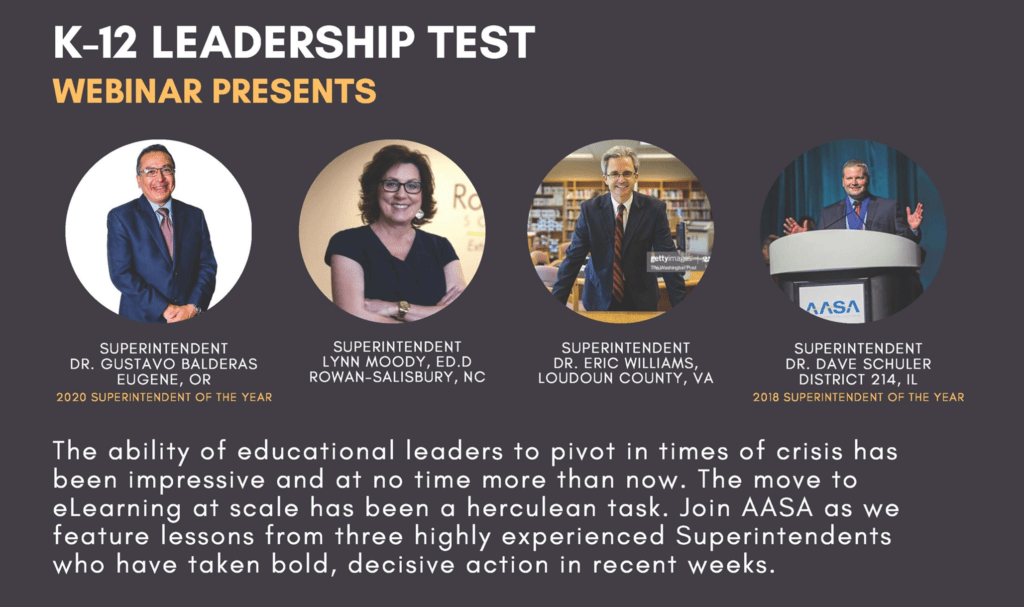
Moody is the superintendent of the Rowan-Salisbury School System, which is known as a renewal school district. According to the district’s website, “The ‘Renewal School System’ model provides charter-like flexibilities for all 34 Rowan-Salisbury Schools. Teachers will be empowered to lead, design, and create how instruction is offered to students.”
“Now that we have this open window, I think it becomes really critically important that we all take advantage of it, and we don’t go back to school the way school always was.” — Lynn Moody
Here is an in-depth playbook Moody authored about leadership before, during, and after COVID-19.
On students
Moody’s district also committed long before COVID-19 “to learner-centered education and what’s right for children.”
Moody and students from the district are co-hosting convenings for students to discuss what they are learning during this time, what’s not working, what is working, and to see what students imagine for the fall.
What’s keeping Moody up at night? Of her almost 20,000 students, the district still hasn’t been in touch with 1,200 since the schools closed because of COVID-19. One of her principals disabled the devices of students with a message instructing the students to contact a teacher in an effort to locate them. Now, the district is engaging school resource officers to deliver book bags to students they can’t find. She notes, “600 of these students are in elementary school. We don’t know if they have opened a book since they left school.”
On parents
Moody says her district is creating instructional videos and other supports for parents, who are serving as co-teachers in this experience.
On teachers
Right now, Moody owns that her district is in survival mode, but they are learning from this experience, and that learning will inform how they move forward educating students in the fall and in the future.
Moody notes the importance of having “the right team, right culture from the beginning.” She hires for three things: energy, execution, and diversity.
She is sending videos to teachers, most recently encouraging them to think about what it is like to teach without the pressure of testing and asking: What do you want to try right now?
This is a “beautiful time to encourage, push, and challenge people to try things they might not have tried before, to see what is working, and to see what we can fix to make it stronger.” — Lynn Moody
On the future
All of the superintendents on the panel discussed how they are crafting different scenarios for moving forward — everything from what happens if they re-open schools but with physical distancing in place to what happens if schools remain closed until a vaccine is available.
When will teachers be able to come back, especially teachers with children? When will students and parents be comfortable coming back? What are the scheduling options if mass gathering caps remain in place? Will masks be necessary or required? And what will bold, courageous leadership looks like in the face of ambiguity?
A link to this webinar will be posted as soon as it is available.
